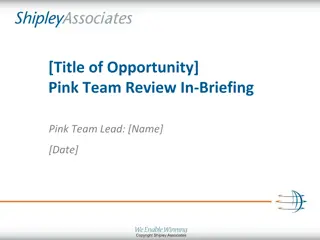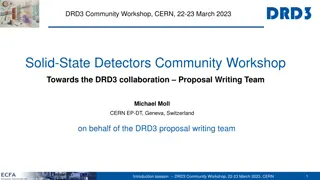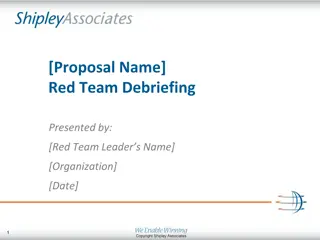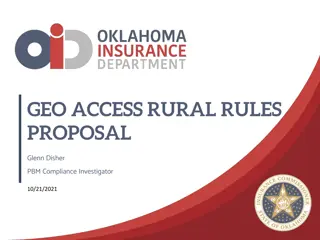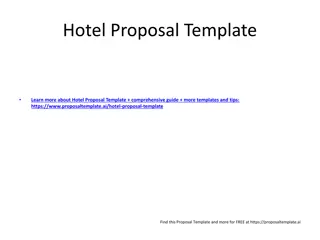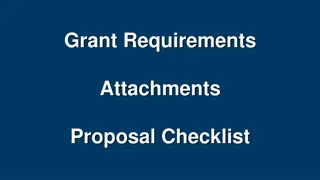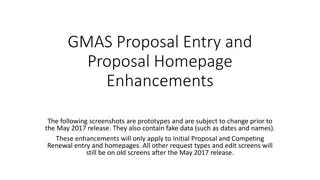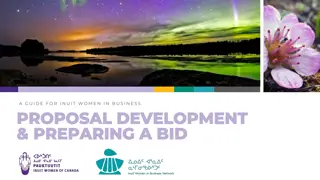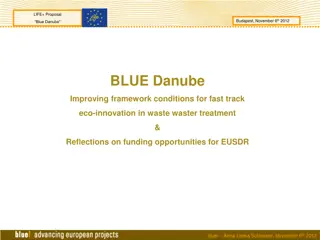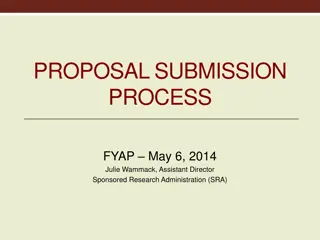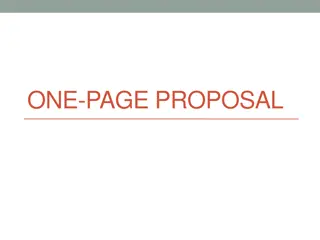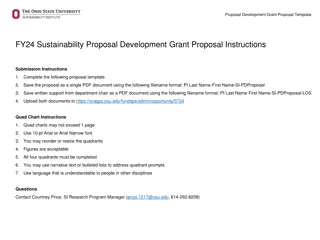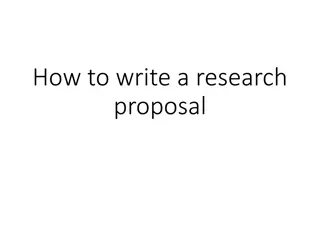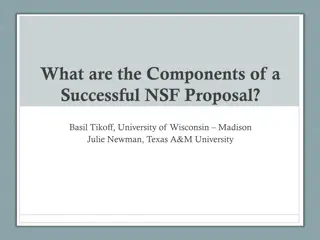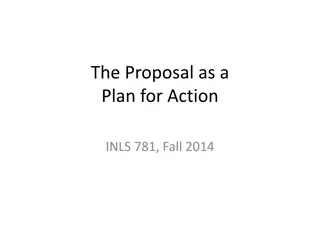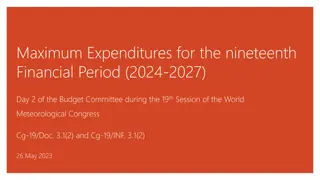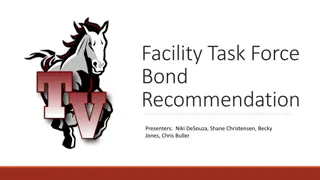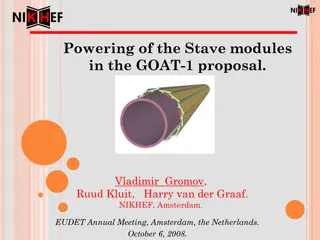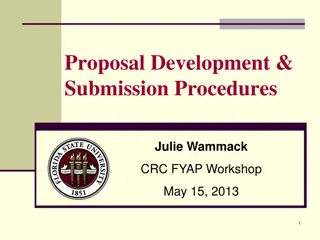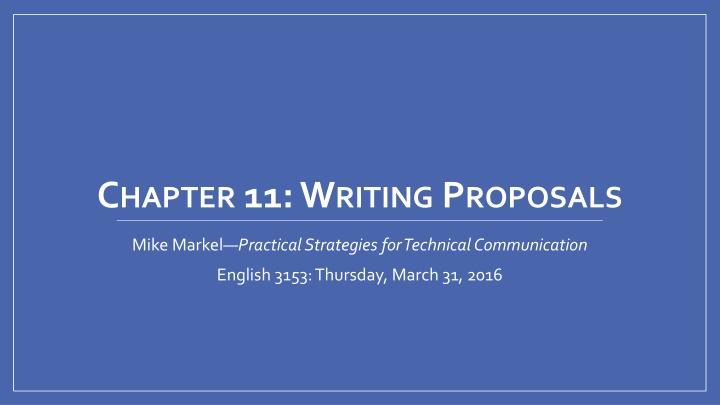
Writing Proposals: Practical Strategies and Features Overview
Learn about the features of proposals, including internal and external proposals, grant opportunities, deliverables, and how to address client needs effectively. Explore the process of writing proposals for offering services, research, requesting funding, and more.
Download Presentation

Please find below an Image/Link to download the presentation.
The content on the website is provided AS IS for your information and personal use only. It may not be sold, licensed, or shared on other websites without obtaining consent from the author. If you encounter any issues during the download, it is possible that the publisher has removed the file from their server.
You are allowed to download the files provided on this website for personal or commercial use, subject to the condition that they are used lawfully. All files are the property of their respective owners.
The content on the website is provided AS IS for your information and personal use only. It may not be sold, licensed, or shared on other websites without obtaining consent from the author.
E N D
Presentation Transcript
CHAPTER 11: WRITING PROPOSALS Mike Markel Practical Strategies for Technical Communication English 3153: Thursday, March 31, 2016
Proposal Overview Features of Proposals: Offer services or propose research. Request funding/permission for projects or the exchange of goods/services. Are either internal or external. May be solicited or unsolicited.
Internal Proposals An internal proposal is an argument, submitted within an organization, for carrying out an activity that will benefit the organization (Markel, 2013, 275). Features of Internal Proposals: Submitted by individuals within the organization. Propose policy changes, recommend products, or request funding for projects/research. May display different levels of detail and formality.
External Proposals Features of Solicited Proposals: Offer goods, services, or research requested (solicited) by other companies or organizations. Are solicited using IFBs or RFPs. IFB (Information for Bid): Searches for the lowest bid. RFP (Request for Proposal): Compares the services and expertise of possible suppliers with their relative costs. Unsolicited Proposals: Offer prospective clients goods and services without any formal solicitation from the client.
Grant Proposals Grant and Fellowship Opportunities: Internal funds from each University department. OU Office of Undergraduate Research. OU Center for Research Program Development and Enrichment. National Science Foundation (information for undergraduates). National Institutes of Health and Grants.gov. Nonprofit organizations (Center for Nonprofit Excellence, Bill and Melinda Gates Foundation, and William T. Grant Foundation).
Deliverables and Clients Deliverables will vary for research and project proposals. Research Proposals: Report the progress, results/data, and completion of research or experiments. Goods and Services Proposals: Supply products and services for the client. Used by the government, non-profit organizations, and corporations/manufacturers. Proposals should show potential clients how your organization can fulfill their stated and unstated needs. How can proposal-writers address the needs of the client if the RFP or IFB does not make this information clear?
Persuasion and Proposals Persuasion Checklist: 1. Understand the needs of the client. a. What are the primary objectives of the client? 2. Describe how you will meet these needs. a. How can we offer the best research/service/price? 3. Explain your qualifications. a. What expertise, methods, procedures, and quality-control measures make us competitive? b. What are our personal and organizational credentials?
Tips for International Proposals Markel connects culture with nationality, but cultures also vary with region, religion, ethnicity, etc. Understand cultural standards for persuasion. Budget enough time for translation. Use simple graphics with clear captions. Write short sentences with simple vocabulary. Use local conventions regarding punctuation. Ask if the customer will read the document.
Proposal Pre-Writing Stage Outline how you will answer the solicitation: Discuss your procedures/methodology, necessary equipment, and justification (if required). Identify the employees involved with the proposal. Consider your credentials: Is your organization well-suited for this proposal? Has your organization handled similar requests? Anticipate technical details such as work schedules, quality- control measures, and budget.
Structure of Proposals Assess the requirements of the solicitation. Government agencies will reject proposals that do not follow their guidelines exactly. Most proposals are evaluated using points sheets (Freedom of Information Act). Some organizations may not have specific directions. Proposals usually include: Executive summaries, introductions, proposed programs/methodologies, qualifications, budgets, and appendices.
Summaries and Abstracts Summaries and Abstracts: Briefly (350-words) summarize the primary components of the proposal. Define the problem confronted by the client and present the solution offered by the proposal. State the qualifications of the organization. May include the completion date and final budget of the proposed research/project.
Introduction Explains the context, scope, and structure of the proposal. Introductions should describe: Problem/opportunity addressed by the proposal. Purpose and scope of the proposal. Background of the problem/opportunity. Relevant sources informing the proposal. Organization proposing research/services. Definitions of specialized vocabulary/terms/acronyms.
Sample Literature Review The field of multiliteracy explores recent evolutions in writing practices due to rapid technological advancements. The advent of the Internet and the emergence of social media has altered the process and demands of writing practices. In response to the increasing demands being placed on students to communicate in a variety of mediums, leading experts Cynthia Selfe (2001) and Jody Shipka (2009) demand a call-to-action for making multimodal composition part of an academically rigorous First-Year Composition (FYC) program. However, more quantitative and qualitative data is needed prior to initiating wide-scale program changes. For this reason, the University of Oklahoma FYC program is seeking funding to conduct an interdisciplinary study that measures the goals and outcomes of a multimodal writing approach.
Proposed Program Explains the methodology, procedure, and quality-control of the proposal. This section contains the majority of the content. Proposed programs should: Explain how you will conduct the research or project from the proposal using relevant source materials. Describe the actual steps recommended by the proposal and the deliverables connected with these procedures. Discuss the quality-control measures integrated into your proposal and the timeline for deliverables.
Evaluation Methods Evaluation methods deserve careful attention from your proposal (particularly for project proposals). Connected with quality-control and are typically assigned high numbers of points. Should mention who will conduct the evaluations (team- members, consultants, etc.). Should specify whether the evaluation methods are qualitative or quantitative.
Qualifications and Experience Describe the qualifications and experience of the organization, team members, and consultants/advisors. Qualifications may include: Specialized technical experience. Previous experience with funded projects. Team members with noteworthy credentials. R sum s, CVs, or biographies of team members. Motivation and resources of the organization.
Budget Often includes short written summary of the costs of the project followed by line-item expenses. Usually includes tables listing expenses. Should indicate direct and indirect costs. Will typically consult the finance department for approval/guidance (especially when the proposal- writers are not accountants).
Appendices Supplemental information that might overcomplicate the proposal or exceed the page limit. Appendices include: Expanded biographies of team members. Detailed history of the organization. More detailed information and graphs for particular concepts/ideas/results (page limits). Testimonials (depending on the context). Note: Appendices are not assigned points.


